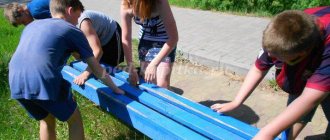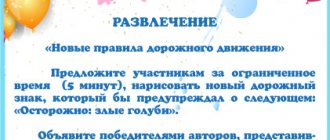This fun game is suitable for a children's party; it can be inserted into any birthday scenario for children from 7 years old. Questions and answers are each written on a separate card. They are all turned over and folded into 2 piles. One contains questions, the other contains answers. Next, each participant is given the opportunity to choose one card with a question and one with an answer. When everyone has pulled out 2 cards, everyone in turn begins to read out their question first, and then the answer to it. It turns out funny.
Questions: Can you tell your friends' secrets? Are your parents punishing you? Do you often have to crow? Do you eavesdrop when your sister talks on the phone? Do you respect your parents? Do you often pick your nose? Does your pen break when you write for a long time? Do you like giving gifts? Do you comb your hair every day? Do you have to wash dishes? Do you often travel on public transport without a ticket? Do you break plates every day? Do you often fall out of bed? Do you cheat from your neighbor's desk? Do you like gifts? Do you often joke with friends? Do you often climb into your neighbor's raspberries? Does your dog listen to you? Are you often lazy? Are you happy that you have to go to school? Do you like to laugh at others? Do you make your bed every day? Do you like to eat sweets? Do you lick your plate after eating? Do you practice sports? Do you trip on your way to school? Do you wash often? Do you cut your toenails in front of guests? Does it happen that you sleep in class? Do you often dream about hippos? Do you like to sleep after lunch? Do you brush your teeth every day? Do you like to crack seeds? Do you have many secrets? Do you wear socks with holes? Do you think that parents should only be told the truth? Do you often visit? Do you like going to the zoo? Do you often run away from classes? Would you walk through the forest at night? Answers: I can't imagine my life without this. Smart people don't give away secrets. Yes, and my dog too! No, the teacher scolds me for this. No, I'm very shy! You won't understand this, I like it so much. You can try it far from home. Of course, this is the most fun thing to do. I don’t know myself, but others say yes. No, it's still no use. This is my hobby. Yes, but our cat gets hysterical because of it. Not here. Every day except today. Why not? With great pleasure! Yes, the neighbors won't stand it soon. If they really ask me about it. Yes, when you need to look smart. I can do it for hours, especially in the dark. Yes, to avoid washing dishes. No, I tried it once and it didn’t work. Only when the weather is bad. How did you guess? Only on an empty stomach. Only on holidays. Oh, have you already been told about this? Only at night. Yes, if you have something to eat. Only if no one sees. Yes, it creates a beastly appetite. Could you ask a more modest question? Yes, they even wrote about it in the newspaper. On Saturdays this is a necessity for me. Yes, the doctor prescribed this for me. This is the main goal of my life. What is it that I can’t see? I just can't stand it. Not always, but often. No, I was too well brought up. Unfortunately no.
Table games for teenagers
Table option. We make 4 types of cards of different colors. Each child takes out one card from each package in turn and reads 4 of their cards. The more unexpected the combination of incompatible things turns out, the more fun the children have. Here are our creatively redesigned kits...
- Jacket potatoes.
- Pasta
- Pieces of meat
- Crispy chips
- Semolina
- Pearl barley
- Peas
- Butter dough
- Spaghetti
- Buckwheat
- Rye crackers
- Cornflakes
- Sausages
- With chocolate spread.
- With herring
- With condensed milk
- With a ram
- With lard
- With ketchup
- With cucumbers
- With watermelons
- With bananas
- With lollipops
- With mayonnaise
- With ice cream
- With children's champagne
- Fill with soda
- Grease with vegetable oil
- Soak in cucumber brine
- Sprinkle with vinegar
- Pour wine
- Beat with a mallet
- Beat with a mixer until foamy
- Place in milk
- Pass through a meat grinder
- Soak in beer
- Put under the press
- Chop into small pieces
- To freeze
- On a wide platter with baked apples
- On a tray with pineapple slices
- In tall glasses with cocktail straws
- In ceramic plates with wooden spoons
- In pots with mustard and chopped herbs
- In bowls with Chinese chopsticks
- In coffee cups with lemon slices
- In tall decanters with narrow necks
- On skewers with fresh champignons
- On small saucers with cracklings
- In beer glasses with nuts
- In foil with lights
- In a frying pan with a lid.
This is when cards are pulled out from two piles. One pack contains questions, and the other contains answers. We read, we laugh, because it turns out to be nonsense. With teenagers, if the holiday is long in time, it goes well.
- Tell me, are you always so impudent?
- Tell me do you love me?
- Tell me, do you cheat in class?
- Tell me, are you erasing the deuces in your diary?
- Do you like giving gifts?
- Is it true that you are secretly married?
- Do you often fall out of bed in your sleep?
- When people don't see you, do you pick your nose?
- Do you sing in the toilet?
- Are you stealing raspberries from your neighbors' dacha?
- Do you like to overeat on cakes at night?
- Is it true that on Mondays you only eat pickles?
- Is it true that you want to change your hair color to purple?
- Have you tried vodka?
- Is it true that your idol is a physical education teacher?
- Is it true that you only sleep in pink elephant pajamas?
- Is it true that you go swimming with rubber duckies?
- Are you crossing the road when it's red?
- Do you brush your teeth in the morning?
- Do you dream of flying to the moon?
- Do you want to act in films?
- Do you write bad words on fences?
- Do you travel on public transport without a ticket?
- Do you like to cry?
- Do you run through puddles?
- I can't imagine my life without this.
- I don't answer political questions.
- No, I'm a very shy person.
- I find it difficult to answer the truth, I don’t want to ruin my reputation.
- Only after I get a bad grade.
- Of course, instead of doing homework.
- When I skip math.
- My blushing is the clearest answer to this question.
- Yes, for hours, especially in the dark.
- Well, you have to! How did you guess?!
- Very rarely, but it happens.
- In principle no, as an exception - yes.
- I have had a penchant for this since childhood.
- If parents don't see.
- On Saturdays this is sacred to me.
- This has long been my greatest desire.
- My modesty does not allow me to answer this question.
- Only April 1st.
- Only on Sunday
- Only in the presence of a policeman.
- This will be announced on television today
- Yes, for company with my best friend.
- No no and one more time no!
- Only together with Santa Claus!
- Just don’t tell your mom, she’ll scold you!
Distribute answer cards to players (one or more at a time). After this, the presenter takes any card with questions and asks a question to the first player. He must take one of his cards at random and read the answer. Then the leader asks a question to the second player, etc. one by one. The game continues until the cards run out.
Card index of questions “Why Chek” for children of the preparatory group
Ekaterina Kalashnikova
Card index of questions “Why Chek” for children of the preparatory group
Card index of questions for “WhyCheck”
Goal: Development of mental processes, logical thinking, coherent speech.
1. Why does an elephant need a trunk?
The trunk is an amazing part of the elephant's body. With its trunk it collects food, drinks, and protects itself from enemies. With its trunk it can lift a huge log and even a small match from the ground. Elephants communicate with each other using their trunk. Mothers touch the forehead of a sick baby with it, as if they want to measure the temperature. Elephants also willingly take dust baths to get rid of skin parasites. With their trunk they scatter dust throughout their body. Young elephants, greeting an unfamiliar elephant, put their trunk in his mouth. This is a sign of trust and love.
2. How does an elephant sleep?
Elephants sleep standing and short. Only young elephants sometimes lie on their sides or stomachs. And the old ones sleep, leaning their tusks on thick branches. Elephants are very smart animals. They have excellent memory. They do not forget kindness and love, but they also remember insults all their lives and can take revenge many years later.
3. How does a kangaroo jump?
Kangaroos are one of the strangest and most ancient animal species on Earth. It is known that hundreds of thousands of years ago there was a species of kangaroo almost the size of a horse! Today, kangaroos can be found in Australia. An adult kangaroo can be up to two meters tall. It has short front legs and very long hind legs. These powerful hind legs allow the kangaroo to jump 3 to 4.5 meters in length! To support and maintain balance while jumping, the kangaroo uses its large, long tail.
4. Why does a camel eat thorns?
The camel is very well adapted to life in the desert, which has very little food. The camel has to make do with thorny bushes and grasses that other desert inhabitants do not eat.
5. Why does a camel need humps?
The humps store fat and water, which it will use up in the desert. The higher the humps, the longer a camel can go without food and water. At the end of the journey, when the fat reserves are used up, the camel's humps will sag and dangle.
6. Why does the giraffe have such a long neck?
The giraffe is a herbivore. But in Africa, where it lives, there is practically no grass, so the only food is trees, which are very tall. The giraffe constantly stretched its neck and gnawed leaves from the branches. The neck stretched and became long. This makes it much more convenient to get food!
7. Why is a zebra striped?
Where zebras live, there are many insects that infect the animals with various infections. The most dangerous is the tsetse fly, the bite of which leads to sleeping sickness. Flies see a zebra from a distance and fly towards it to bite it. But up close they see a “fence” of clear black and white stripes that scares them away. This is how zebras have adapted to protect themselves from harmful insects.
8. How do rabbits differ from hares?
There are many differences between hares and rabbits. Hares are larger and have longer legs and ears. Hares do not dig holes and do not live in herds like rabbits. Hares are born with their eyes open and with fur, while rabbits are born blind and hairless. Hares and rabbits never interbreed. There are also similarities. Hares and rabbits are rodents, which means they have long, sharp front teeth. Their hind legs are longer than their front legs, which is why they run much faster uphill than downhill! They can also warn each other of danger by drumming on the ground with their hind legs. Hares and rabbits are vegetarians, but they can get by on just tree bark and grass.
9. Why does a hare have long ears?
To hear better! Ears raised high above the grass allow you to hear a predator at a distance, which means you can run away faster. To avoid overheating! When running away from a predator, the hare becomes very hot, so while running it needs to remove heat from the body, which is what its ears do. And since the ears are narrow and long, it is much more convenient to press them to yourself without interfering with running or clinging to branches.
10. Why do some animals sleep in winter?
Animals that hibernate in winter feed on plants and fruits. In the warm season, animals eat enough, fat is deposited in their bodies with a supply of all the necessary nutrients. So when they cannot find food for a long time, they crawl deep into their holes and fall asleep. Fat supplies the animal with nutrition during sleep. Animals hide, as if petrifying for the winter. Body temperature drops to such a level that the animal becomes only slightly warmer than the surrounding air. If the temperature in the den becomes very low, the hibernating animal wakes up, buries itself deeper and goes back to sleep. When spring comes, animals are awakened by changes in temperature, humidity and hunger. Then they crawl out of their lairs.
11. Who is the echidna?
The echidna is one of the strangest animals you can see. The echidna has long claws, a tube-like muzzle, and a covering of short, hard spines, reminiscent of the spines of a hedgehog or porcupine. But the strangest thing is that this mammal lays eggs! That's why it is called a bird beast. The main food of the echidna is ants and insects. The echidna digs holes with short and powerful legs equipped with curved claws, and catches insects with a long and sticky tongue capable of stretching far. The echidna lays its eggs in a sac located on its stomach. There the cubs hatch and live until they become crowded. In case of danger, the echidna immediately buries itself in the ground right on the spot, and the enemy sees only its sharp needles in front of him. It only takes a few minutes for an echidna to completely burrow into the ground!
12. Who is a sloth?
Sloths are mammals native to Central and South America. They got their name from the fact that they sleep 18 hours a day. Sloths live in forests. They sleep in trees, using their paws and fingers to hold themselves on branches with their backs down, upside down. Sometimes they crawl to the ground, find a river or lake, dive there and swim easily. The sloth's fur is gray and shaggy. Sometimes algae grows in the fur and it takes on a greenish tint. This helps the sloth to be completely invisible to eagles, jaguars and other predators.
13. Who is an armadillo?
It turns out that this is an animal covered with a bony shell that resembles armor. The shell consists of a plate on the head and two on the back. On the back, the plates are connected by a movable strip that allows the animal to turn and spin. The tail also has armor. However, the armadillo's teeth are quite soft, and it is forced to eat soft food - ants, beetles and their larvae. But he has sharp claws and very strong front paws in order to dig holes and hide in them from enemies. An armadillo can dig faster than a dog!
14. What is a manatee?
The manatee resembles a small whale and is a mammal. The American manatee reaches a length of 2.5-4 meters. The body structure resembles a fish, but its tail is wide, spade-shaped, with rounded edges. The manatee has thick, hairless skin, except for the “antennae” on its upper lip. Manatees live in bays, lagoons and large rivers, preferring shallow water. Manatees eat plants. They use their fins to push food into their mouths. A manatee eats from 27 to 45 kilograms of food per day. Manatees are often called sea cows because, like cows, they graze in shallow waters and often gather in small herds. And to feed the baby, the mother rises to the surface of the water and, sticking her head and shoulders out of the water, presses the baby to her chest with her fins. Manatees move very slowly and are absolutely harmless.
15. How do dolphins sleep?
In all animals, birds and humans, when deep sleep occurs, changes occur in the brain: both in the left hemisphere and in the right. But dolphins cannot sleep like that, because they live in water, but breathe air, and if they fall asleep deeply, they will drown and will not be able to rise to the surface to take in air for the next breath. Or maybe dolphins don't sleep at all? Scientists have found that in dolphins, the right and left hemispheres of the brain sleep in turns. So, for example, the left one is asleep, and the right one controls the dolphin and sends it to the surface to breathe air. Then the hemispheres change roles. And when they get enough sleep, they get back to work at the same time.
16. Where did the different breeds of dogs come from?
Dogs were domesticated before other animals. Since then, people have developed more than 200 dog breeds. In some cases, breeds were bred for specific needs. Often, when entering new countries, dogs either mated with local wild dogs or modified themselves to adapt to a foreign climate. So in warm Mexico there are smooth-haired dogs, and in the Far North there are long-haired dogs. There are hunting dogs that follow scents in the air, hounds that hunt by scent, terriers that dig holes during the hunt, service dogs, toy dogs, and all kinds of crossbreeds.
17. Why are pigs called guinea pigs?
The Spaniards were the first to see this animal and called it a pig because it resembled a small (suckling) pig. Pigs were brought to Russia from overseas on ships. So they were called “overseas”, and then simply “sea”. Everyone is accustomed to this name, although the guinea pig has nothing to do with the sea or pigs
18. Why is the lion called the king of beasts?
Because he looks truly regal. His golden mane gives him the majesty of a monarch. The lion's voice is no less impressive than its appearance. The lion's roar evokes awe in all who hear it. In his behavior, the lion shows many royal qualities. Man has always revered the lion for its nobility, courage, loyalty and power as an invincible fighter.
19. Why do bats sleep upside down?
Scientists believe that such a strange habit appeared millions of years ago. After a night hunt, bats flew under the arches of caves to get a good night's sleep, hiding from their enemies. It was possible to stay “under the ceiling” only by catching the claws of the hind paws on a stone ledge and hanging upside down. This is how bats learned to sleep upside down. Over time, their femurs became thinner and the bats simply forgot how to sit and stand on their hind legs!
20. Is it true that the bear loves honey?
Is it true! The word “bear” comes from the words “honey” and “ved” (to know). The bear really loves to eat honey, like children love sweets. But despite this, the bear is the most formidable inhabitant of the taiga. He is a strong and fearless beast.
21. Which animal is the largest?
The largest animal on earth is the blue whale. Its length is about 30 meters and its weight is more than 150 tons. The whale's head is about a quarter of the entire body, and the heart (just imagine) is the size of a small car. The blue whale is believed to be the largest animal to ever exist, larger than even a dinosaur. Even a baby blue whale is larger than an elephant, the largest animal living on land.
22. Which animal lives the longest?
It is believed that turtles live the longest lives - more than 100 years. One Moorish tortoise lived 152 years. And scientists say that this is not the limit!
23. How did dinosaurs appear?
Dinosaurs appeared about 180 million years ago and went extinct about 60 million years ago. The ancestors of dinosaurs are reptiles that could live both in water and on land. Eggs were laid only on the ground, and the young had lungs and could breathe air. Then the reptiles became bigger and stronger. Some resembled turtles, others - large lizards. They had short tails, thick legs and large heads. They ate plants. The first dinosaurs resembled reptiles that could walk on their hind legs, about the size of a turkey. Some remained small, while others grew longer and heavier. There were also 6-meter long ones that weighed as much as an elephant. They had small heads and short, blunt teeth for chewing plant matter. Such dinosaurs lived in low, swampy places. Some herbivorous dinosaurs became so large that even on four legs they could not support themselves on land. So the brontosaurus, 20-24 meters long and weighing about 34 tons, lived in rivers and swamps. At the same time, other dinosaurs (for example, Allosaurus) could easily move on the ground, despite their 10-meter height. They had sharp teeth and claws and fed on brontosauruses and other herbivorous dinosaurs. Dinosaurs disappeared due to climate change, which deprived them of food and habitats.
24. Why did dinosaurs become extinct?
Scientists are still arguing about why these animals became extinct. Most of them claim that many, many millions of years ago a huge asteroid fell on our planet. The blow was so powerful that a huge cloud of dust rose into the sky. It covered the Sun. Without sunlight, all the plants died, and the dinosaurs died out from starvation.
25. Why does a crocodile look like a dinosaur?
Because crocodiles are the closest relatives of dinosaurs among living animals. Many dinosaurs had the same skin covered with scales. The difference is that dinosaurs had more developed legs. They were located under the body, not on the sides, and were much more powerful than those of crocodiles.
26. Why don’t birds fall from branches in a dream?
In order to hold something in your hand, you need to tense your fist, but the legs of birds are designed the other way around - when a bird sits on a branch, its claws grab onto it, but to let go of the branch, birds need to try hard, and in a dream, birds, like and we are relaxed.
27. Why do birds have feathers?
Many years ago, the ancestors of birds had scales. But in the process of development, it began to turn into feathers. Essentially, feathers are another form of the substance that forms horns, tails and hooves in other animals. When a bird hatches from an egg, its body is covered with down. It is soft and fluffy. This soon changes to true outline feathers that form the outline of the bird's body. The feather consists of a rod that is hollow inside. During growth, nutrients are delivered to the tip of the feather through it. The color of feathers depends on the pigment found in the substance that forms them. But it may also depend on the food the bird eats. Feathers vary in structure and size. So in a hawk they are short and fit tightly to the body, allowing them to fly at high speed. And the owl's feathers are soft and fluffy, which allows it to fly quietly, but not quickly. In waterfowl (swan, goose, duck, etc.), the feathers are moistened with an oily liquid, which makes them waterproof.
28. Why does an ostrich hide its head in the sand?
It's a delusion! An ostrich never hides its head in the sand. When this bird senses danger, it lies on the ground, stretches its neck and watches. If danger approaches, the ostrich simply jumps up and runs away.
29. Why can a duck swim?
The duck's feet are webbed, they help it stay on the water. In addition, they are located at the back of the body. This position helps the duck to swim, and when walking it creates a funny waddling gait.
30. Why doesn’t a duck freeze in cold water?
One reason is the waterproof feathers that tightly cover the duck's body, as well as the thick layer of down under the feathers. In addition, ducks' feet are devoid of blood vessels and nerve endings, so they do not feel the cold.
31. Why is the secretary bird called that?
This bird got its name thanks to the tufts of feathers that stick out on the back of its head. It looks as if the bird had put feathers behind its ear for writing, as secretaries used to do.
32. Why are flamingos pink?
Because flamingos love to eat algae, which contain special dyes. If flamingos are deprived of such nutrition, they will gradually become almost white. This is what happened in some zoos, until scientists realized that it was all about nutrition.
33. Why do sparrows bathe in the sand?
Sparrows do not have many feathers compared to other birds. Therefore, they are forced to keep them clean, floundering in water, dust and sand. In this way, sparrows get rid of insects and dirt on their bodies. And to scare away insects, sparrows carry branches of wormwood and parsley into their nests so that the smell will repel pests.
34. How do fish swim and why do they not sink or float to the surface?
If you throw a heavy object into the water, it will sink to the bottom, but if it is a rubber ball, then it will remain on the surface of the water. The body of the fish is dense, it pulls down. But inside she has a “ball” - a swim bladder, which is filled with air and pulls to the surface. Thanks to this combination, the fish swims in the water column.
35. What are snowflakes made of?
Snowflakes are ice crystals that look like compounds of needles and plates. Cirrus clouds in the sky consist of many such crystals. They grow, turn into snowflakes, get heavier - and fall down. Snowing. A snowflake is a gentle, capricious formation. If the temperature, wind direction, or humidity changes, this immediately affects its size and “physique.” A humid wind is blowing, the snowflakes are slightly melting at the ends and forming flakes; frosty - the needles are all clearly drawn
36. Why is snow white?
If you put two objects - black and white - in the sun's rays, they will warm up differently. So a black object will absorb the sun's rays and warm up more than a white object, which will only reflect them. If the object is colorless, then the rays will simply pass through it. A snowflake consists of ice crystals. And ice has no color. It is colorless. Therefore, a ray of light passes through every snowflake and remains colorless. But the snowflakes fall to the ground and lie in disarray. All together they become opaque, do not allow rays to pass through them, but, on the contrary, reflect them into our eyes. And, therefore, we see snow as white.
37. What is an iceberg?
An iceberg is a huge floating block of ice that breaks off from polar glaciers or ice floes floating in the Arctic Ocean. Some icebergs are enormous, reaching 800 meters in height. Only an eighth of the iceberg rises above the water, and the rest is under water, so icebergs are very dangerous for ships. A special international commission monitors their movements and warns ships of the danger.
38. What is ice?
Ice is frozen, solid water. Once you warm a piece of ice in your palm, it will immediately flow from your fingers in a thin stream.
39. Why doesn't ice sink?
Ice is lighter than water. That's why he never sinks, but always floats on top.
40. How are ice icicles formed?
In order for ice icicles to form, it is necessary to have two temperatures at the same time: for melting - above zero and for freezing - below zero. The sun heats the snow on the slope of the roof to a temperature above zero and it melts. And the flowing drops of water at the edge of the roof freeze, because the temperature here is below zero. The frozen drop is covered by the next one, which also freezes, then the third drop, and so on; a small icy tubercle gradually forms. Another time, in the same weather, these ice flows lengthen and icicles form, sometimes growing to enormous sizes.
41. What is hail?
Hail, which sometimes falls during a thunderstorm in the summer, is also ice. These ice balls froze high, high in the sky and did not have time to melt as they flew to the ground along with the rain. The icicle is the sister of ice.
42. Why does it rain?
The sun warms up the water in the ocean, sea, river and any puddle. The water evaporates, turns into warm steam and rises to the top. From the earth heated by the sun, steam climbs high to where it is constantly, even on the hottest summer day, as cold as in winter and again turns into droplets of water. They are very small, light and mobile. The droplets dance, merge and become larger. This is how a cloud appears. And when the droplets become large, they can no longer stay above and fall to the ground. This is how it rains on earth.
43. Where do waves come from?
Waves on the water are created by the wind. You've probably noticed that in calm weather there are almost no waves on the water, but on a windy day there are a lot of them.
Why is the Dead Sea called this?
The Dead Sea is a lake filled with salt water located on the border of Jordan and Israel. The lake is so salty that no fish can live there, hence the name - the Dead Sea. The amount of salts only allows you to stay on the surface of the lake, but not to swim. In the Dead Sea you can even lie quietly while reading a book.
44. Why is the sky blue?
The whole secret turns out to be in the air (atmosphere) and the sun. The air itself is colorless. So, at night we see the atmosphere as it is - transparent. Through the air you can see black space, stars, and other planets. When the day comes and the sun comes out, its rays penetrate the air. The light in it breaks down into seven colors - red, orange, yellow, green, blue, indigo, violet. There are more blue and blue colors, which is why it seems that the sky is blue-blue. It turns out that space during the day is, as it were, closed from us by a blue curtain, hiding its secrets and riddles.
45. What is a sunbeam?
When the Sun shines, its rays fly straight, next to each other and fall together to the Earth. But a ray can break away from its fellow rays and fall not on the Earth, but on a reflective object, for example, on a mirror. Then he will smile at his reflection and blind you with his smile. A sunbeam is a piece of sunlight, a ray that has taken a different path, not like everyone else.
46. Who builds the rainbow?
Rainbows are made by the sun's rays and raindrops. The rain is ending. The last drops are still falling to the ground, and the sun is already peeking out from behind the clouds. The rays of the sun pass through the raindrops - and then an unusually beautiful arc appears in the sky opposite the sun.
47. How many colors are there in the rainbow?
There are 7 colors in the rainbow. They are always arranged in the same order: red, orange, yellow, green, blue, indigo and violet. It’s easy to remember the sequence of colors if you remember this phrase: “Every hunter wants to know where the pheasant is sitting.” The first letter of each word will remind you of the name of the color. For example, “everyone” is red, “hunter” is orange, “wants” is yellow, etc.
48. Where does the rainbow go?
When the rain subsides, the rainbow disappears from the sky, as if someone is erasing it. When we look at a rainbow from the ground, it appears to us as an arc. And if you look at a rainbow from a height, for example from an airplane, it will seem like a circle to us.
49. Who came up with the names of the planets?
All the planets of our solar system, with the exception of the Earth, were named in honor of the gods and goddesses of Ancient Rome and Ancient Greece - Venus, Mars, Jupiter, etc. The ancient Romans and Greeks believed that gods and goddesses lived in the heavens. Ancient astronomers, who believed that the Earth is the center of the universe, and planets and stars revolve around it, came up with the names of new planets and decided to use the names of their mythological celestials. And our planet, since it was not considered part of the heavens, was called “Earth,” which means “from the ground.”
50. What is a cloud?
A cloud or cloud is an “accumulation” of excess moisture, which is transformed into many small droplets of water and ice crystals. Warm air filled with moisture rises into the sky. When it reaches a certain height, it cools down. And we see a cloud in the sky. At a lower temperature, it can no longer contain all its moisture in the form of water vapor. And it rains. Clouds have different shapes because they form at different altitudes and at different temperatures.
51. Why do clouds have different shapes?
All clouds are made of thin pieces of ice. Depending on what height from the ground they were formed, as well as on what was included in their composition in addition to water droplets, clouds have different shapes and appearances. Dark, shapeless, lumpy - these are rain clouds (cumulus, carrying thunderstorms and strong winds. Others, like a veil, envelop the sky (layered, and the moon and sun peek through them as pale spots. And on a clear sunny day you can see small round clouds (feather, about them we say “the sky is in lamb.”
52. What is fog?
Fog is a cloud! It descended to the surface of the earth. There is no difference between fog and cloud in the sky. When a cloud is near the surface of the earth or water, we call it fog.
53. What is air?
Although you cannot see, taste or touch air (at least in calm weather), air is by no means empty. Air is part of the matter that surrounds us. Matter can be solid, liquid or gas. Air is almost always in a gaseous state. Air surrounds us on all sides. Every crack, hole, and in general any space not occupied by anything else is filled with air. Every time you inhale, you fill your lungs with air. Air is a mixture of gases, the main of which: nitrogen, oxygen, carbon dioxide. Air has weight. And it presses on us, although we sometimes don’t feel it. The same thing would happen to you if you found yourself on the seabed, with the only difference being It would not be air that would press on you, but water.











